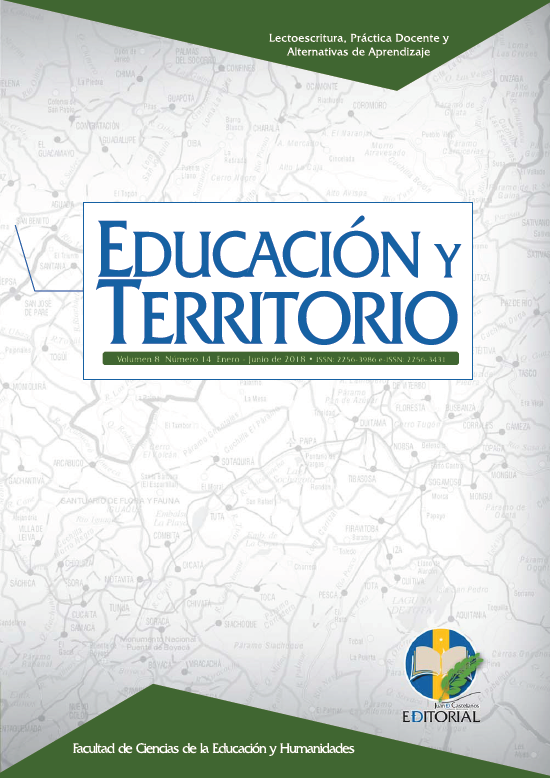DOI:
https://doi.org/10.38017/22563989.668Keywords:
multiple intelligences, dominant intelligence, teach, teacher’s beliefs, teaching strategiesAbstract
This article stems from ongoing research aimed to analyze the teacher’s Multiple Intelligences, the relationship with their thoughts and their strategic decision making in the classroom. Based on the great variety of research carried out worldwide since the publication Frames of Mind (Gardner, 1983), it has been widely discovered the relationship that the types of Intelligence have with the way of perceiving knowl- edge and comprehend it within the limits of the immediacy. Even so, the works that have been developed regarding the teacher’s cognitive profile and the connection of their work with their own perception of learning are insufficient. This research is developed under the methodology of mixed approach with dominant status and sequential order quantitative→QUALITATIVE. The present article concludes that the teaching practice must start from the self-reflection as learning beings and the in- terferences that the cognitive profile have within the practice as teachers, necessary action to raise awareness of the teaching methods within the classroom.
Downloads
References
Ball, D. & Feiman-Nemser, S. (1988). Using textbooks and teacher’s guides: A
dilemma for beginning teachers and teacher educators. Curriculum Inquiry,
18(4), 401-423.
Cordero, D. y Pizzarro, G. (2011). Estrategias de Enseñanza Innovadoras: un reto para el docente actual. Revista Ensayos Pedagógicos, 6(2), 189-203.
Creswell, J. (2008). Mixed Methods Research: State of the Art. University of
Michigan. Recuperado de http://www.mixedmethods.org/
Dolati, Z. y Tahriri, A. (2017). EFL Teachers’ Multiple Intelligences and Their Classroom Practice. SAGE Open Journal. Doi: https://doi. org/10.1177/2158244017722582.
D’Ors, A. y Pérez, P. (1993). El profesor. Revista chilena de derecho, 20(1),
107-114.
Espinosa, E. (2016). La reflexión y la mediación didáctica como parte funda- mental en la enseñanza de las ciencias: un caso particular en los procesos de la formación docente. Revista Tecné, Episteme y Didaxis: TED., (40),
175-209.
Gálvez, J. et al. (1999). Interés por Aprender Vs. Necesidad de Aprobar. Argentina, Córdoba: Universidad de Córdoba.
Gardner, H. (1983). Frames of mind, the theory of Multiple Intelligences. New York: Basic Books.
Gardner, H. (1995). Inteligencias Múltiples, la teoría en la práctica (1.a Ed.).
Barcelona, España: Espasa Libros S.L.U.
Ghamrawi, N. (2014). Multiple Intelligences and ESL Teaching and Learning: An Investigation in KG II Classrooms in One Private School in Beirut, Lebanon. Journal of Advanced Academics, 25(1), 25-46.
Gould, J. (1981). La falsa medida del hombre. Buenos Aires: Orbis Ediciones. Grossman, P. (1988). A study in contrast: sources of pedagogical content knowledge
for secondary English. (Doctoral dissertation). Stanford University, Stanford,
CA.
Grossman, P., Wilson, S. y Shulman, L. (2005). Profesores de Sustancia: El Conocimiento de la Materia para la Enseñanza. Profesorado. Revista de Currículum y Formación del Profesorado, 9(2), 1-24.
Gunst, G. A. (2004). A study of multiple intelligences among teachers in Catholic elementary schools in the Archdiocese of Detroit (Doctoral dissertation). Wayne State University, Míchigan, EE. UU. Recuperado de http://elibrary.wayne. edu/record=b3041404~S47
Gurney, P. (2007). Five factors for effective teaching. New Zealand Journal of
Teachers’ work, 4(2), 89-98.
Harvard Graduate School of Education. Project Zero. (1967, 2013). (URL).
Recuperado de http://www.pz.harvard.edu/
Johnson, B. y Onwuegbuzie, A. (2004). Mixed Methods Research: A Research Paradigm Whose Time Has Come [Los métodos de investigación mix- tos: un paradigma de investigación cuyo tiempo ha llegado]. Educational Researcher, 33(7), 14-26. Recuperado de http://edr.sagepub.com/cgi/ content/abstract/33/7/14
Latorre, M. y Blanco, F. (2007). Algunos conceptos clave en torno a las creencias de los docentes en formación. Docencia e investigación, (2), 1-19. Recuperado de http://hdl.handle.net/10578/8093
Montemayor, M., García, M. y Garza, Y. (2006). Guía para la Investigación
Documental. México, D.F: Trillas, S.A. de C.V.
Moyano, M. y Giordano, M. (2011). Estrategias de enseñanza en la formación docente. Revista Didáctica y Educación, (2), 1-10.
Paredes, A. (2007). Pedagogía Serie 1 para docentes de Secundaria. Nuevos paradigmas educativos Fascículo 8: LAS INTELIGENCIAS MÚLTIPLES. Ministerio de Educación Van de Velde.
Ramírez, E. (2014). How does a pedagogical and including environment based on Howard Gardner’s Multiple Intelligences Theory (IM) improve the English teaching – learning processes in third grade of elementary school. Tunja: UPTC.
Serin, N, Serin, O, Yavuza, A, y Muhammedzadea, B. (2009). The relationship between the primary teachers’ teaching strategies and their strengths in multiple intelligences (Their multiple intelligence types) (Sampling: Izmir and Lefkosa). Procedia Social and Behavioral Sciences, 1, 708-712. Doi: doi. org/10.1016/j.sbspro.2009.01.124
Stipek, D. (1996). Motivation and Instruction. In D.C. Berliner & R.C. Calfee (eds.), Handbook of Educational Psychology (pp. 85-113). New York: Simon & Schuster McMillan.
Vargas, A. (2015). El oficio del maestro y su influencia en el rendimiento escolar desde una perspectiva de la escuela multigrado y graduada. Tunja: Universidad Pedagógica y Tecnológica de Colombia.





